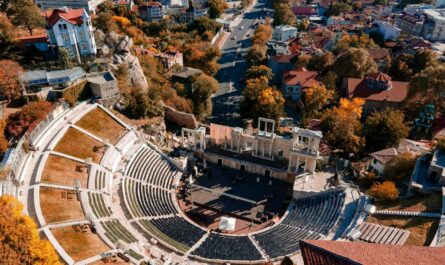Greece, a land of myth and legend, has captivated the hearts and minds of travelers for centuries. Beyond its crystal-clear waters, charming islands, and delectable cuisine, Greece is also home to a treasure trove of cultural and historical gems. Many of these extraordinary sites have earned the prestigious UNESCO World Heritage status, a testament to their outstanding universal value. In this blog post, we embark on a journey to explore the UNESCO-listed sites of Greece, where ancient tales come to life, and the whispers of history echo through time.
- Acropolis of Athens:
Our journey begins with perhaps the most iconic symbol of Greece, the Acropolis of Athens. Perched atop a rocky outcrop, this ancient citadel is a marvel of classical architecture and engineering. Dominated by the Parthenon, dedicated to the goddess Athena, the Acropolis offers a panoramic view of Athens. As you wander through the Propylaea, the Erechtheion, and other structures, you can’t help but feel a deep connection to the birthplace of Western civilization.
- Delphi:
Nestled on the slopes of Mount Parnassus, Delphi is a sacred site that was once considered the center of the world in ancient Greek religion. The Temple of Apollo, the Theater, and the Tholos of Delphi are among the well-preserved structures that transport visitors back to the days of the Oracle. The site’s mystical atmosphere and breathtaking surroundings make Delphi an unforgettable experience.
- Olympia:
Home to the ancient Olympic Games, Olympia is an archaeological site that exudes athletic prowess and cultural significance. The Temple of Zeus, the Temple of Hera, and the ancient stadium are just a few of the structures that showcase the grandeur of this sacred sanctuary. Walk in the footsteps of ancient athletes and imagine the roar of the crowds that once filled the stadium during the historic games.
- Meteora:
Moving away from the mainland, we venture into the mystical region of Meteora, where monasteries seemingly defy gravity by perching atop towering rock pillars. These monasteries, dating back to the 14th century, provide not only a spiritual retreat but also offer breathtaking views of the unique landscape below. Meteora is a testament to the harmonious coexistence of nature and human ingenuity.
- Mystras:
Traveling to the Peloponnese, we encounter the medieval wonder of Mystras. Nestled on a hillside, this fortified town boasts well-preserved Byzantine churches, palaces, and fortifications. Stroll through the labyrinthine streets, explore the Palace of the Despots, and marvel at the frescoes that adorn the churches – Mystras is a time capsule preserving the splendors of a bygone era.
- Epidaurus:
In the northeastern part of the Peloponnese, the ancient sanctuary of Epidaurus beckons with its well-preserved theater and healing sanctuary. The Theater of Epidaurus, renowned for its exceptional acoustics, once hosted dramatic performances and festivals in honor of the god Asclepius. As you stand in the center of this marvel, imagine the resonance of ancient Greek tragedies echoing through the limestone seats, captivating audiences in a celebration of art and healing.
- Rhodes Medieval City:
Transport yourself to the medieval era as you step into the UNESCO-listed Rhodes Medieval City. Encircled by imposing fortifications, this well-preserved medieval town unfolds like a living history book. Walk through the Street of the Knights, lined with grandiose inns once inhabited by the Order of the Knights of Saint John, and discover the Palace of the Grand Master, a testament to the island’s strategic importance during the Crusades.
- Monasteries of Daphni, Hosios Loukas, and Nea Moni of Chios:
These three Byzantine monasteries are scattered across Greece, each telling a unique tale of religious devotion and artistic mastery. The mosaics at Daphni, the architecture of Hosios Loukas, and the decorative elements of Nea Moni of Chios reveal the Byzantine Empire’s cultural richness. These monasteries not only showcase the spiritual heritage of Greece but also underscore the significance of Byzantine art in the broader context of world heritage.
- Mount Athos:
Nestled on a peninsula in Northern Greece, Mount Athos stands as a monastic community devoted to prayer, contemplation, and spiritual asceticism. With its twenty monasteries, Mount Athos is a UNESCO-listed site that provides a unique insight into Orthodox Christian monasticism. Accessible to male pilgrims only, the area remains a secluded haven, inviting those seeking spiritual reflection to witness a way of life rooted in tradition.
- Ancient City of Thessaloniki:
The second-largest city in Greece, Thessaloniki, boasts an ancient past that comes alive in its archaeological sites. From the imposing Rotunda and the Arch of Galerius to the Roman Forum and the intricate mosaics of the House of Dionysus, the city unfolds layer upon layer of history. Thessaloniki’s UNESCO listing showcases its role as a significant crossroads of civilizations, blending Roman, Byzantine, and Ottoman influences.
- The Sanctuary of Asclepius at Corinth:
Situated near the ancient city of Corinth, the Sanctuary of Asclepius stands as a testament to the ancient Greeks’ reverence for healing and well-being. Dedicated to the god of medicine, Asclepius, this sanctuary features a healing center and an impressive temple surrounded by other structures. Pilgrims from across the ancient world sought solace and cures here, making it a pivotal site in the historical landscape of Greek medicine.
- Pythagoreion and Heraion of Samos:
The island of Samos, known for its lush landscapes and crystal-clear waters, is also home to UNESCO-listed sites that showcase the island’s ancient significance. Pythagoreion, named after the famous mathematician Pythagoras, boasts ancient fortifications, a tunnel, and the Eupalinian aqueduct, a marvel of ancient engineering. The Heraion, dedicated to the goddess Hera, comprises a sanctuary and the ruins of a colossal temple, offering a glimpse into the island’s religious and scientific contributions to ancient Greece.
- The Archaeological Site of Philippi:
In the northeastern part of Greece, near the city of Kavala, lies the archaeological site of Philippi. Once an important city in ancient Macedonia, Philippi features ruins from various historical periods, including Hellenistic, Roman, and early Christian. The ancient theater, the Forum, and the remains of Basilicas highlight the city’s diverse history, from its foundation by Philip II of Macedon to its role in early Christianity.
- The Historic Centre (Chorá) with the Monastery of Saint-John the Theologian and the Cave of the Apocalypse on the Island of Pátmos:
Pátmos, a serene island in the Dodecanese, is renowned for its spiritual significance. The Monastery of Saint-John the Theologian and the Cave of the Apocalypse are integral to the island’s UNESCO recognition. The monastery, a medieval fortress-like structure, houses priceless religious artifacts, while the cave is believed to be where Saint John received the visions recorded in the Book of Revelation, making Pátmos a pilgrimage site for Christians.
- Archaeological Site of Mycenae:
Mycenae, perched atop a hill in the northeastern Peloponnese, is a UNESCO-listed site that unveils the splendors of ancient Greek civilization. The Lion Gate, the Cyclopean Walls, and the Treasury of Atreus are among the archaeological marvels that transport visitors to the heroic age of Greece. Mycenae’s rich history, including its association with the legendary King Agamemnon, adds a mythical dimension to this archaeological gem.
- Archaeological Site of Vergina:
Venturing into northern Greece, the archaeological site of Vergina offers a glimpse into the royal tombs of the ancient kingdom of Macedon. Discovered in the late 20th century, the tombs of Philip II and other members of the royal family showcase opulent burial practices and intricate artifacts. The site, with its vivid murals and royal treasures, sheds light on the grandeur of the Macedonian dynasty and its pivotal role in shaping the course of history.
- Archaeological Site of Eleusis:
Eleusis, located near Athens, was the site of the ancient Eleusinian Mysteries, one of the most sacred religious rites in ancient Greece. The Sanctuary of Demeter, the Telesterion, and the Plutonian are key structures that played a central role in these mysterious and revered ceremonies. The site’s UNESCO status recognizes its importance as a center of spiritual initiation and the worship of Demeter and Persephone.
- Archaeological Site of Dodona:
Tucked away in the Epirus region, Dodona is home to one of the oldest and most revered oracles in ancient Greece. The Archaeological Site of Dodona comprises remnants of a sacred theater, a sanctuary dedicated to Zeus, and the renowned Oracle of Dodona. The site’s significance in ancient divination practices and its serene natural surroundings contribute to its UNESCO recognition.
- The Old Town of Corfu:
The Old Town of Corfu, an island in the Ionian Sea, is a UNESCO-listed site that reflects the island’s Venetian, French, and British influences. Narrow cobblestone streets, fortresses, and elegant Venetian architecture characterize this well-preserved town. With its blend of cultures, the Old Town of Corfu is a living testament to the island’s strategic importance throughout history.
Conclusion
Greece’s UNESCO-listed sites are not mere remnants of the past; they are living testaments to the enduring legacy of a civilization that has shaped the course of history. As you explore these sites, you’ll find yourself immersed in the rich tapestry of Greece’s cultural heritage, where every stone tells a story and every ruin whispers secrets of times long gone. Whether you are a history enthusiast, an architecture aficionado, or simply a wanderer seeking profound experiences, Greece’s UNESCO-listed sites promise a journey through the ages, leaving an indelible mark on your soul.




